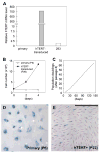Establishment and characterization of Fabry disease endothelial cells with an extended lifespan
- PMID: 17644384
- PMCID: PMC2063578
- DOI: 10.1016/j.ymgme.2007.06.003
Establishment and characterization of Fabry disease endothelial cells with an extended lifespan
Abstract
Fabry disease is an inborn error of glycosphingolipid catabolism resulting from a deficiency of lysosomal enzyme alpha-galactosidase A. The major clinical manifestations of the disease, such as stroke, cardiac dysfunction, and renal impairment, are thought to be caused by vasculopathy due to progressive accumulation of globotriaosylceramide in vascular endothelial cells. The pathogenesis of the vasculopathy has not been elucidated. Since in vitro studies using primary endothelial cells are hampered by the limited lifespan of these cells, the availability of cultured endothelial cells with an extended lifespan is critical for the study of the vasculopathy of Fabry disease. We therefore generated an endothelial cell line from a Fabry hemizygote by introduction of human telomerase reverse transcriptase gene. The cell line has markedly extended lifespan compared to parental primary cells. The cells stably express many key markers of endothelial cells such as von Willebrand factor, CD31, CD34, and endothelial nitric oxide synthase (eNOS) and retain functional characteristics such as uptake of acetylated low-density lipoprotein, responsiveness to angiogenic growth factors, up-regulation of eNOS production upon extracellular stimuli, and formation of tube-like structures on Matrigel basement membrane matrix. The cells show significantly reduced activity of alpha-galactosidase A compared with primary endothelial cells from normal individuals and accumulate globotriaosylceramide in lysosomes. This cell line will provide a useful in vitro model of Fabry disease and will facilitate systematic studies to investigate pathogenic mechanisms and explore new therapeutic approaches for Fabry disease.
Figures




Similar articles
-
α-galactosidase A deficiency promotes von Willebrand factor secretion in models of Fabry disease.Kidney Int. 2019 Jan;95(1):149-159. doi: 10.1016/j.kint.2018.08.033. Epub 2018 Nov 22. Kidney Int. 2019. PMID: 30470436 Free PMC article.
-
In vitro expression of the endothelial phenotype: comparative study of primary isolated cells and cell lines, including the novel cell line HPMEC-ST1.6R.Microvasc Res. 2002 Nov;64(3):384-97. doi: 10.1006/mvre.2002.2434. Microvasc Res. 2002. PMID: 12453433
-
Decreased nitric oxide bioavailability in a mouse model of Fabry disease.J Am Soc Nephrol. 2009 Sep;20(9):1975-85. doi: 10.1681/ASN.2008111190. Epub 2009 Jul 23. J Am Soc Nephrol. 2009. PMID: 19628671 Free PMC article.
-
Anderson-Fabry disease: a multiorgan disease.Curr Pharm Des. 2013;19(33):5974-96. doi: 10.2174/13816128113199990352. Curr Pharm Des. 2013. PMID: 23448451 Review.
-
Complement System and Adhesion Molecule Skirmishes in Fabry Disease: Insights into Pathogenesis and Disease Mechanisms.Int J Mol Sci. 2024 Nov 14;25(22):12252. doi: 10.3390/ijms252212252. Int J Mol Sci. 2024. PMID: 39596318 Free PMC article. Review.
Cited by
-
Novel Golden Lipid Nanoparticles with Small Interference Ribonucleic Acid for Substrate Reduction Therapy in Fabry Disease.Pharmaceutics. 2023 Jul 12;15(7):1936. doi: 10.3390/pharmaceutics15071936. Pharmaceutics. 2023. PMID: 37514122 Free PMC article.
-
Endothelial Cell Dysfunction and Hypoxia as Potential Mediators of Pain in Fabry Disease: A Human-Murine Translational Approach.Int J Mol Sci. 2023 Oct 21;24(20):15422. doi: 10.3390/ijms242015422. Int J Mol Sci. 2023. PMID: 37895103 Free PMC article.
-
Enhanced thrombospondin-1 causes dysfunction of vascular endothelial cells derived from Fabry disease-induced pluripotent stem cells.EBioMedicine. 2020 Feb;52:102633. doi: 10.1016/j.ebiom.2020.102633. Epub 2020 Jan 23. EBioMedicine. 2020. PMID: 31981984 Free PMC article.
-
Mannose receptor-mediated delivery of moss-made α-galactosidase A efficiently corrects enzyme deficiency in Fabry mice.J Inherit Metab Dis. 2016 Mar;39(2):293-303. doi: 10.1007/s10545-015-9886-9. Epub 2015 Aug 27. J Inherit Metab Dis. 2016. PMID: 26310963 Free PMC article.
-
Globotriaosylceramide induces oxidative stress and up-regulates cell adhesion molecule expression in Fabry disease endothelial cells.Mol Genet Metab. 2008 Nov;95(3):163-8. doi: 10.1016/j.ymgme.2008.06.016. Epub 2008 Aug 15. Mol Genet Metab. 2008. PMID: 18707907 Free PMC article.
References
-
- Brady RO, Gal AE, Bradley RM, Martensson E, Warshaw AL, Laster L. Enzymatic defect in Fabry’s disease. Ceramide trihexosidase deficiency. N Engl J Med. 1967;276:1163–1167. - PubMed
-
- Desnick RJ, Ioannou YA, Eng CM. α-Galactosidase A deficiency: Fabry disease. In: Scriver CR, Beaudet AL, Sly WS, Valle D, editors. The Metabolic and Molecular Bases of Inherited Disease. 8. McGraw-Hill; New York: 2001. pp. 3733–3774.
-
- Moore DF, Kaneski CR, Askari H, Schiffmann R. The cerebral vasculopathy of Fabry disease. J Neurol Sci. 2007 [Epub ahead of print] - PubMed
-
- Heare T, Alp NJ, Priestman DA, Kulkarni AB, Qasba P, Butters TD, Dwek RA, Clarke K, Channon KM, Platt FM. Severe endothelial dysfunction in the aorta of a mouse model of Fabry disease; partial prevention by N-butyldeoxynojirimycin treatment. J Inherit Metab Dis. 2007;30:79–87. - PubMed
Publication types
MeSH terms
Substances
Grants and funding
LinkOut - more resources
Full Text Sources
Medical
Research Materials

